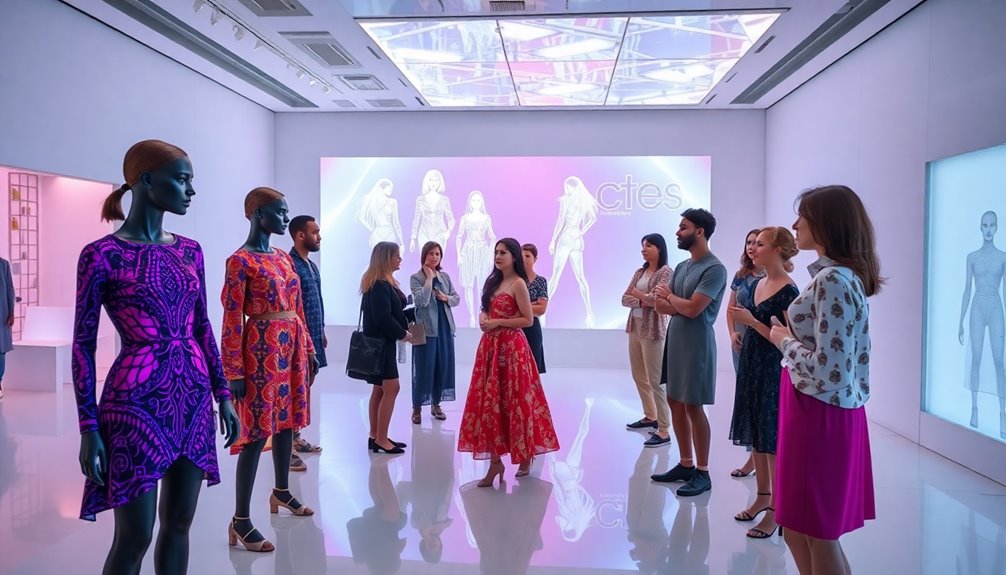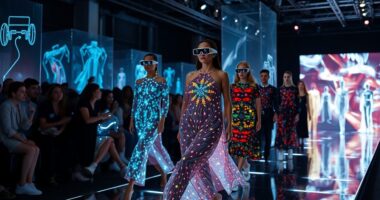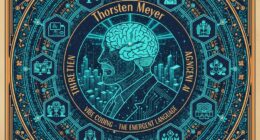Virtual clothes are reshaping the fashion landscape in exciting ways. As you explore digital fashion, you'll find a booming market projected to hit $50 billion by 2030. NFTs play an essential role by providing verifiable ownership and authenticity for these digital assets. With the rise of eco-conscious consumers, virtual wardrobes offer a sustainable alternative, drastically reducing material waste. Brands are embracing this trend, creating exclusive digital collections that foster community engagement. As you consider how these shifts might impact your style choices, you'll discover even more about this fascinating intersection of fashion and technology.
Key Takeaways
- The digital fashion market is projected to reach $50 billion by 2030, indicating strong future growth potential for virtual clothing.
- NFTs provide verifiable ownership and authenticity for digital garments, enhancing their appeal and security in the fashion industry.
- Sustainable practices in digital fashion reduce waste and environmental impact, aligning with the eco-conscious values of modern consumers.
- Enhanced consumer engagement through AR technology and virtual try-ons positions digital fashion as a preferred shopping experience for many.
- Challenges like copyright issues and accessibility must be addressed to fully realize the potential of virtual clothes in the fashion landscape.
The Rise of Digital Fashion
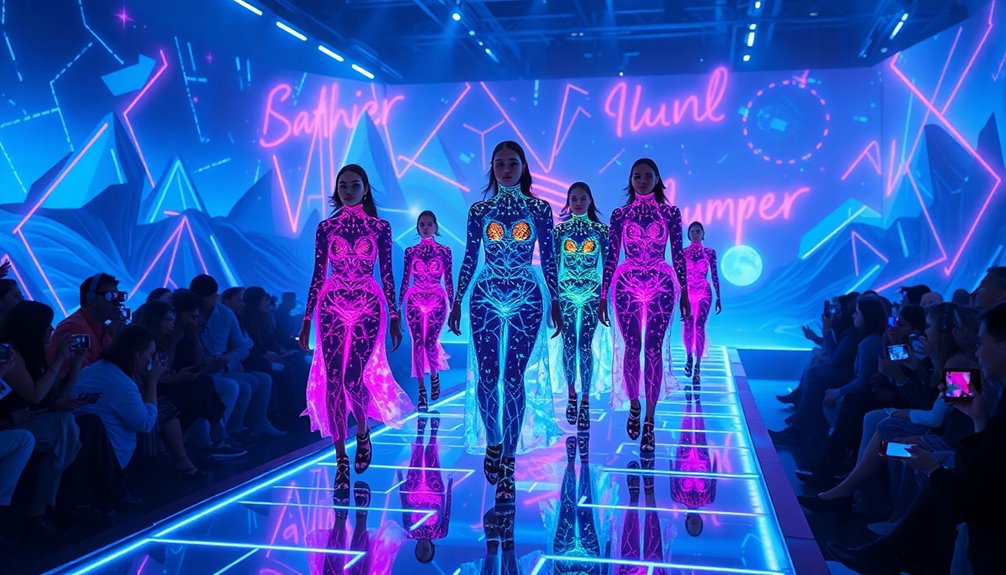
As the digital landscape evolves, you can see the rise of digital fashion taking center stage. This burgeoning market, projected to reach $50 billion by 2030, showcases virtual clothing designed through advanced 3D software.
Major brands and designers like Gucci and Balenciaga are diving into the NFT space, blending luxury with innovative digital experiences. With virtual wardrobes, you can express your identity while minimizing environmental impact by reducing the need for physical materials.
The growing popularity of online gaming has also fueled demand for unique digital clothing, enhancing avatar customization. NFTs not only verify ownership of these virtual items but also redefine collectibility, allowing you to trade and sell unique pieces in an ever-evolving fashion landscape. Additionally, AI-driven analysis plays a crucial role in optimizing digital fashion strategies, ensuring brands effectively reach their target audiences.
Understanding NFTs in Fashion
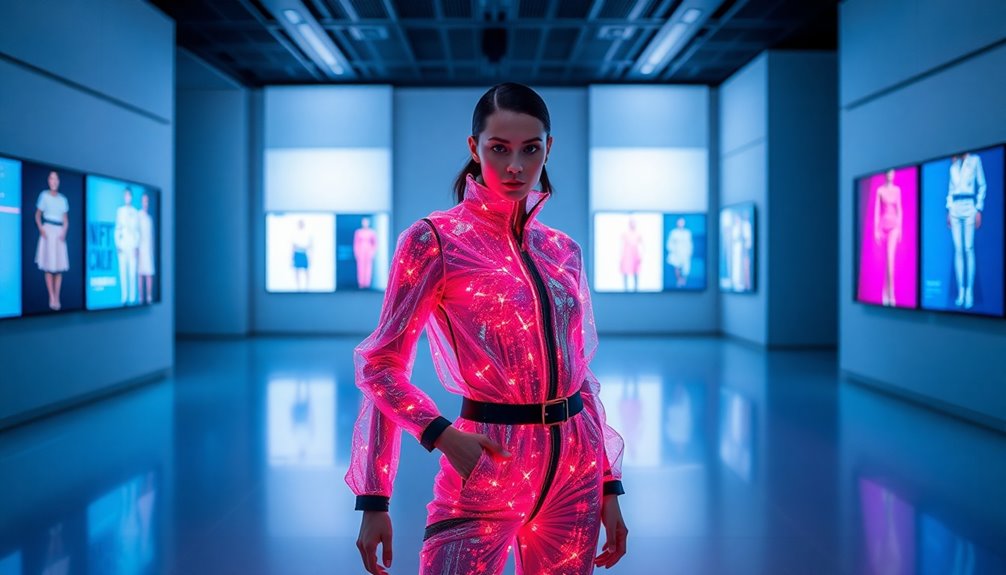
Understanding NFTs in fashion involves recognizing how these unique digital tokens transform ownership and authenticity in the industry.
These NFTs in fashion leverage blockchain technology to create verifiable ownership histories for digital assets, ensuring that virtual clothes are both unique and authentic.
Key aspects include:
- Exclusive Digital Collections: Limited-edition pieces that enhance collectibility.
- Immutable Proof of Ownership: Tokenization prevents counterfeiting and secures ownership rights.
- Market Growth Potential: The digital fashion market could reach $50 billion by 2030.
As you explore this evolving landscape, you'll see how NFTs are reshaping consumer engagement, elevating the value of fashion items through their inherent scarcity and uniqueness.
This new paradigm could redefine how you perceive and interact with fashion. Additionally, just as chia seeds provide numerous health benefits in a plant-based diet, the integration of NFTs in fashion offers innovative advantages for collectors and brands alike.
Virtual Wardrobes and Consumer Behavior
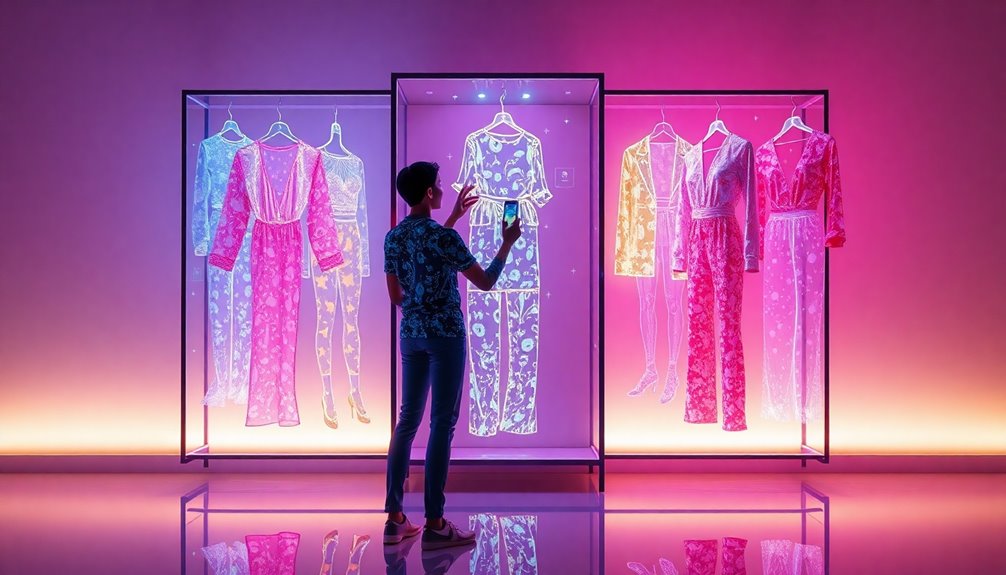
While the rise of virtual wardrobes reshapes consumer behavior, it also reflects a broader trend towards digitalization in fashion. You now have the chance to own collections of digital clothing tailored for various virtual environments, greatly enhancing sustainability in your fashion consumption.
The projected $40 billion market for virtual wardrobes highlights how you're shifting towards avatar customization and metaverse fashion. With innovative materials and animated elements created through 3D software, digital clothing allows for limitless creativity and self-expression.
As you curate and showcase your digital identity, virtual wardrobes elevate your shopping experience, aligning with your desire for personal expression. This transformation in consumer behavior marks a considerable step towards a more sustainable and imaginative future in fashion.
Major Brands Embracing the Metaverse

With the rise of the metaverse, major brands are seizing the opportunity to redefine their engagement strategies. Nike and Adidas are leading the charge, with Nike launching Nikeland in Roblox and Adidas collaborating with The Sandbox for enhanced digital experiences.
Luxury brands like Gucci and Louis Vuitton are also exploring virtual environments, creating immersive experiences that resonate with younger audiences.
Key strategies include:
- Creating unique digital experiences that drive traffic, like Gucci Garden attracting over 20 million visitors.
- Leveraging gaming partnerships, as seen with Balenciaga and Fortnite, to boost brand awareness.
- Fostering inclusivity through personalized avatar customization in virtual fashion ecosystems.
These moves signal a shift in how fashion products are marketed and consumed in the metaverse.
Sustainable Practices in Digital Fashion

As the fashion industry grapples with its environmental impact, digital fashion emerges as a compelling solution that combines creativity and sustainability.
By utilizing digital clothing, you eliminate the need for raw materials, dyes, and transportation, promoting sustainable practices. This shift not only reduces waste but also allows brands to explore limitless creativity without contributing to physical garment production.
With the virtual fashion market projected to reach $50 billion by 2030, NFTs linked to digital items support a circular economy, enabling ownership, resale, and trade.
Major brands are recognizing this potential, integrating eco-consciousness into their digital collections.
As you embrace these innovations, you're participating in a movement that prioritizes responsible consumption and environmental stewardship in the evolving fashion landscape. Additionally, the fashion industry's shift towards sustainable practices aligns with broader efforts to reduce waste and promote environmental responsibility.
The Role of Augmented Reality
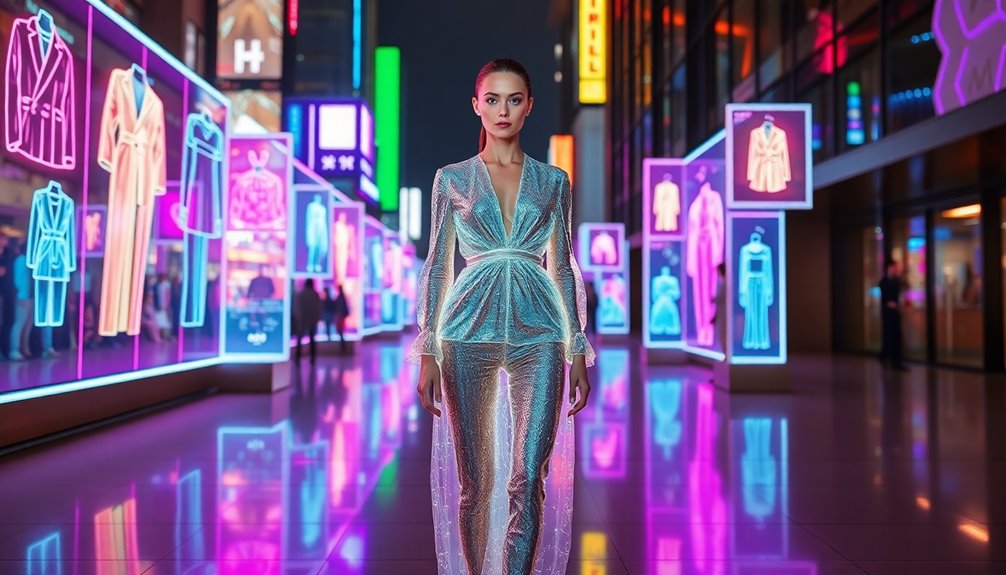
Augmented reality is transforming the way you shop by allowing you to virtually try on clothes before buying.
This tech creates immersive experiences that make it easier to mix and match digital outfits, bridging the gap between physical and digital fashion.
As you explore these innovations, you're not just engaging with products; you're stepping into a new era of fashion consumption. Furthermore, the integration of community collaboration in fashion tech initiatives highlights how these advancements can foster social change and enhance consumer interaction.
Enhancing Virtual Try-Ons
When you explore the world of digital fashion, you'll find that augmented reality (AR) is transforming how you shop. With AR technology, you can virtually try on digital clothes, enhancing your shopping experience and allowing real-time visualization of garments on your avatar.
Major fashion brands are increasingly integrating AR features, making the process more interactive.
Consider these benefits:
- Reduced Return Rates: See how virtual clothes fit and move before purchasing.
- Increased Customer Engagement: Users are 11 times more likely to buy after using AR fitting rooms.
- Social Media Influence: Showcase your digital wearables and influence fashion trends online.
This innovative approach not only personalizes your experience but also makes shopping more enjoyable. Additionally, the use of on-device processing ensures that your personal data remains secure while you explore virtual fashion options.
Immersive Shopping Experiences
Imagine stepping into a virtual fitting room where you can see how clothes fit you without ever leaving your home. Augmented reality (AR) is revolutionizing immersive shopping experiences, allowing you to try on virtual clothes using digital avatars. This technology enhances consumer interaction and helps you visualize garments in real-time, reducing return rates. Major brands like Gucci and Warby Parker are leading the charge, integrating AR features to boost engagement. Additionally, AI-driven personalization is also enhancing the shopping experience by tailoring recommendations based on individual consumer preferences.
Here's a glimpse into the impact of AR on shopping:
| Aspect | Benefit | Impact on Sales |
|---|---|---|
| Consumer Engagement | Real-time visualization | 71% report positive experience |
| Return Rate Reduction | Fewer returns | Higher sales conversions |
| Market Growth | $61.4 billion by 2023 | Reshaping fashion trends |
Bridging Physical-Digital Worlds
As you explore the world of fashion, the integration of augmented reality (AR) technology seamlessly blends the physical and digital domains. This innovative approach allows you to virtually try on digital clothing, creating a more engaging shopping experience.
Consider these benefits of AR in fashion:
- Realistic Visualization: See how virtual garments fit your avatar before making a purchase.
- Enhanced Self-Expression: Showcase your virtual outfits on social media and connect with others.
- Consumer Preference: With 70% of consumers favoring virtual try-ons, AR is reshaping shopping behavior.
As the market for AR in retail is projected to hit $61.4 billion by 2030, it's clear that this technology plays a crucial role in connecting consumers with the digital fashion world.
Community Engagement and Fashion
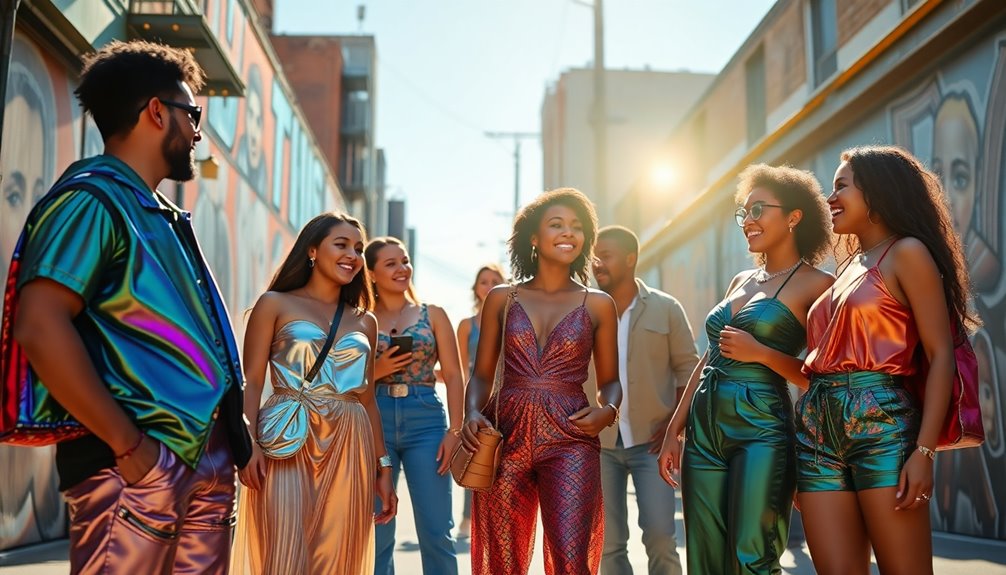
How are fashion brands transforming community engagement through NFTs?
They're creating exclusive digital collections that not only enhance community engagement but also offer unique experiences for consumers. Major brands like Balenciaga and Lacoste are leveraging NFTs to connect with you, integrating digital assets into their marketing strategies.
Platforms like Discord and Twitter play significant roles in this evolution, keeping you updated on NFT releases and virtual fashion shows. These community-driven ecosystems, powered by smart contracts, allow NFT holders like you to participate in exclusive events and collaborations, fostering deeper connections with the brands you love.
The rise of events like Metaverse Fashion Week showcases how digital spaces are reshaping consumer relationships, promoting inclusivity, and making fashion more accessible than ever. Additionally, brands are utilizing Natural Language Processing to enhance customer interactions and tailor their marketing efforts, further deepening community ties.
Future Trends in Virtual Clothing
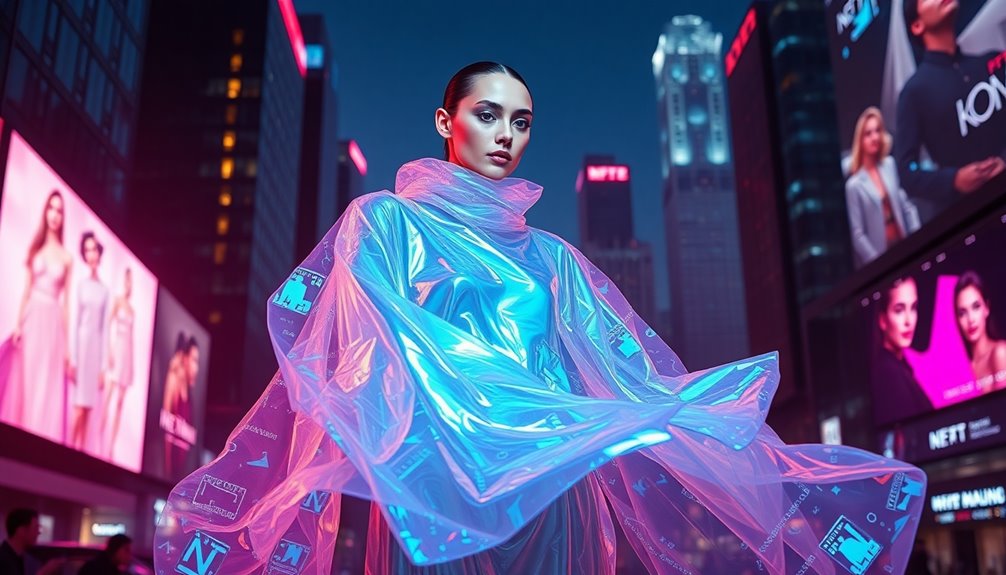
As the virtual fashion industry grows, you'll see innovative sustainable options that reduce waste while still pushing creative boundaries.
Enhanced avatar customization will allow you to express your unique style like never before, making every digital outfit a true reflection of you.
Get ready for a future where fashion isn't just worn, but experienced in exciting new ways.
Sustainable Fashion Innovation
While traditional fashion often comes at a high environmental cost, the rise of virtual clothing is paving the way for sustainable innovation in the industry.
Digital clothing considerably reduces the environmental footprint by eliminating raw materials, dyes, and transportation needs. As the virtual fashion industry is projected to hit $50 billion by 2030, it's clear that sustainable fashion is more than just a trend.
Consider these key aspects of sustainable fashion innovation:
- NFTs guarantee ownership and authenticity while promoting responsible consumption.
- Brands like The Fabricant and DressX lead in eco-conscious digital fashion offerings.
- Virtual wardrobes allow you to curate collections without physical constraints, reducing material waste.
Additionally, the mindful art of decluttering encourages conscious consumption, aligning personal values with sustainable practices in fashion.
Embracing these innovations creates a more sustainable future for fashion.
Enhanced Avatar Customization
With the evolution of virtual environments, enhanced avatar customization has become a game-changer in how you express your individuality online.
Platforms like Roblox are leading this trend with features like Layered Clothing, allowing you to craft unique digital assets for your avatars. The demand for digital clothes is skyrocketing, projected to reach $50 billion by 2030, thanks to gaming giants like Fortnite and Call of Duty setting the stage for avatar customization.
Augmented reality (AR) also plays a role, making virtual wardrobes more interactive. Plus, these innovations promote sustainable practices by reducing the need for physical materials.
With limitless creative possibilities, you can truly showcase your style without the constraints of the real world.
Challenges Facing Digital Fashion

Maneuvering the digital fashion landscape isn't without its hurdles, particularly when it comes to copyright and intellectual property rights. Protecting unique digital designs and NFTs can be complicated, and as the market grows, you'll face additional challenges:
- Standardizing virtual clothing sizing and fit to enhance consumer satisfaction.
- Addressing accessibility issues to guarantee diverse user demographics can engage with digital fashion.
- Tackling environmental concerns tied to the energy consumption of blockchain technology. In fact, Bitcoin mining consumes approximately 0.5% of global electricity, highlighting significant sustainability issues that digital fashion must consider.
Moreover, the rapid evolution of this space highlights the need for ongoing consumer education. Helping users grasp the value and functionality of digital clothing and NFTs will be essential for adoption rates.
Without addressing these challenges, the future of digital fashion could be uncertain.
The Impact of NFTs on Ownership
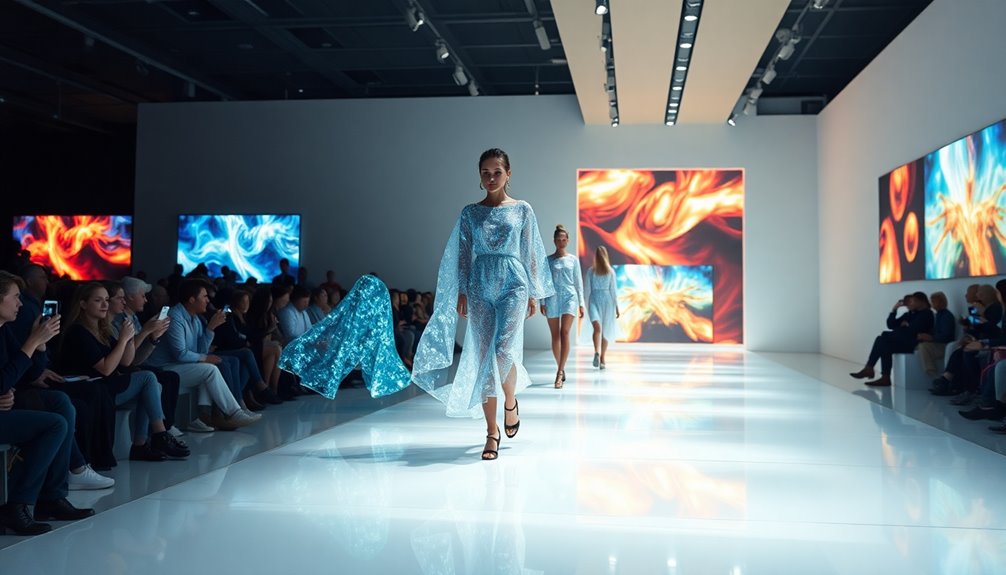
NFTs are changing how you think about ownership in fashion by providing a secure way to verify authenticity through blockchain technology.
With unique digital assets, you can enjoy the benefits of scarcity and increased value, making your virtual wardrobe feel truly special.
Plus, these innovations help combat counterfeiting, giving you confidence in your digital fashion investments.
Ownership Verification Through Blockchain
As the fashion industry grapples with counterfeiting, blockchain technology emerges as a game-changer in ownership verification. NFTs serve as digital certificates, ensuring authenticity and reducing concerns over fake items.
Here's how they transform digital fashion:
- Smart contracts securely define ownership and transferability.
- QR codes on physical clothing link to NFTs, providing ownership history.
- Each NFT contains metadata confirming its uniqueness.
With the potential market value of NFTs in fashion projected to reach $50 billion by 2030, the significance of ownership verification through blockchain is undeniable.
Embracing this technology not only enhances authenticity but also empowers you as a consumer to trade or sell your digital fashion assets seamlessly within the metaverse.
Digital Scarcity and Value
While the fashion world evolves, digital scarcity introduced by NFTs is reshaping how we perceive ownership and value. NFTs create unique digital fashion items that exist on the blockchain, ensuring secure ownership and verifiable authenticity.
This tokenization transforms fashion pieces into distinct digital assets that can be bought, sold, or traded, establishing a new paradigm in the industry. The scarcity and uniqueness of NFT fashion items enhance their perceived value, attracting consumers willing to invest in exclusive digital collectibles.
With luxury brands like Gucci and Balenciaga entering the NFT space, we see a clear shift towards digital ownership. The digital fashion market is projected to reach $50 billion by 2030, driven by demand for limited-edition virtual clothes fueled by NFTs.
Counterfeit Prevention Mechanisms
The rise of NFTs has introduced powerful counterfeit prevention mechanisms in the fashion industry. With NFTs, you can verify the authenticity and ownership of fashion items, making it much harder for counterfeit products to thrive.
Here are a few key benefits:
- Digital Certificates: NFTs serve as secure digital proof of ownership, ensuring originality.
- Blockchain Transparency: The transparent nature of blockchain allows you to trace the provenance of fashion items easily.
- Unique Metadata: Each NFT contains specific metadata, confirming its uniqueness and making replication nearly impossible.
Frequently Asked Questions
Is Digital Clothing the Future of Fashion?
You might find that digital clothing is shaping the future of fashion.
With its limitless creative potential, it allows you to express yourself without the constraints of physical materials. As major brands immerse themselves in this space, you're witnessing a shift in how ownership and collectibility are perceived.
Plus, embracing virtual wardrobes can help you make more sustainable choices. The digital fashion market is booming, and it's likely to keep growing, offering exciting possibilities for everyone.
What Are Fashion NFTS?
Imagine owning a piece of digital art that you can wear—this is what fashion NFTs offer.
They're unique digital tokens authenticated by blockchain technology, representing ownership of virtual fashion items. When you buy a fashion NFT, you're not just acquiring a digital garment; you're securing a status symbol in a virtual world.
These tokens redefine ownership, allowing you to collect, showcase, and even access exclusive experiences tied to your digital wardrobe.
What Is the Fashion Metaverse?
The fashion metaverse is a digital landscape where you can explore, create, and engage with virtual fashion.
It blends augmented and virtual reality, allowing you to customize avatars and interact in immersive 3D environments.
You'll find major brands like Gucci and Adidas showcasing their collections, making it a vibrant space for creativity and inclusivity.
Plus, owning digital wardrobes promotes sustainable fashion by minimizing physical waste, making your fashion choices more eco-friendly.
What Exactly Are NFTS Used For?
Imagine owning a piece of art that only you can display, yet it's entirely digital. That's where NFTs come in.
You use them to secure ownership of unique digital assets, like art, music, or virtual goods. They authenticate your purchase and allow you to resell with confidence, knowing the provenance is tracked.
Plus, creators can earn from resales, turning digital ownership into a sustainable income source. Isn't that a game-changer for both artists and collectors?
Conclusion
As you explore the vibrant domain where fashion meets NFTs, you'll discover a thrilling blend of creativity and technology. Imagine flaunting virtual outfits that redefine ownership while promoting sustainability. Yet, amidst this digital revolution, challenges linger, reminding you that innovation comes with its quirks. The future of fashion, rich with virtual possibilities, invites you to embrace both the excitement and uncertainty. So, are you ready to step into a domain where your wardrobe transcends reality?



